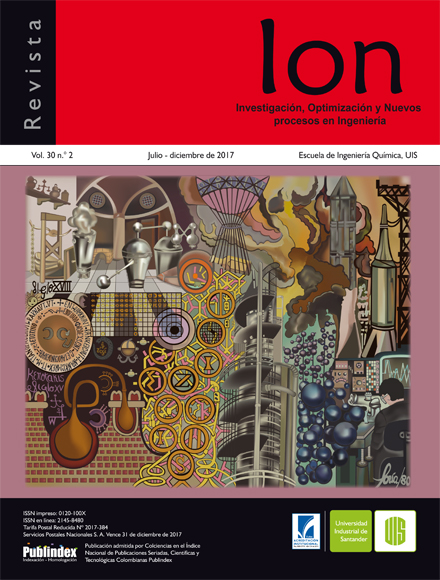Evaluation of antioxidant potential in a spinach extract by cyclic voltammetry
Published 2018-05-07
Keywords
- free radicals,
- oxidative stress,
- cyclic voltammetry,
- spinach extract,
- antioxidant potential
How to Cite
Abstract
The antioxidant capacity of plant extracts has been studied by voltammetric techniques thanks to its sensitivity, selectivity, low cost, simplicity and speed. In this research, Cyclic Voltamperometry was used to study the antioxidant potential and stability in ethanolic extracts of spinach leaves (Spinacia oleracea) over time. The extracts were obtained after ultrasound of macerating spinach leaves with industrial ethanol. The potentiometric sweeps of the extracts at 0, 7 and 15 days of preparation were carried out in a Sørensen buffer. Electrodes of Au (work), Ag/AgCl (reference) and Pt (auxiliary) were used from -1.2 to 1.2V. The results showed a high antioxidant capacity of the extracts (oxidation potentials below 600mV) and a decrease in the current while the extracts preservation (0, 7 and 15 days), which allows the conclusion that its Antioxidant potential decreases over time describing a first-order kinetic. Also, the results of the antioxidant capacity were correlated with the Folin Ciocalteu method.
Downloads
References
[2] Zhang D, Hamauzu Y. Phenolics, ascorbic acid, carotenoids and antioxidant activity of broccoli and their changes during conventional and microwave cooking. Food Chem. Elsevier. 2004;88(4):503–9.
[3] Oroian M, Escriche I. Antioxidants: Characterization, natural sources, extraction and analysis. Food Res Int. 2015;74:10–36.
[4] La A, Toro R, Fredy G, López V, Taipe M. Evaluación De La Actividad Antioxidante Del Pisco Peruano Mediante Voltametría Cíclica. Rev Soc Quím Perú. 2011;77(2):127–34.
[5] Sochor J, Dobes J, Krystofova O, Ruttkaynedecky B, Babula P, Pohanka M, et al. Electrochemistry as a Tool for Studying Antioxidant Properties. Int. J. Electrochem. Sci. 2013;8:8464–89.
[6] Ruiz-Montoya M, Palma A, Alonso-Garrido G, Pintado S, Chemistry P, Chemistry O, et al. Comparison of the Simple Cyclic Voltammetry (CV) and DPPH Assays for the Determination of Antioxidant Capacity of Active Principles. 2012;5126–38.
[7] Zieliński H, Zielińska D, Kostyra H. Antioxidant capacity of a new crispy type food products determined by updated analytical strategies. Food Chem. 2012;130(4):1098–104.
[8] Simić A, Manojlović D, Segan D, Todorović M. Electrochemical behavior and antioxidant and prooxidant activity of natural phenolics. Molecules. 2007;12(10):2327–40.
[9] Brcanović JM, Pavlović AN, Mitić SS, Stojanović GS, Manojlović DD, Kaličanin BM, et al. Cyclic voltammetry determination of antioxidant capacity of cocoa powder, dark chocolate and milk chocolate samples: Correlation with spectrophotometric assays and individual phenolic compounds. Food Technol Biotechnol. 2013;51(4):460–70.
[10] Piovesan JV, Jost CL, Spinelli A. Electroanalytical determination of total phenolic compounds by square-wave voltammetry using a poly(vinylpyrrolidone)-modified carbon-paste electrode. Sensors Actuators B Chem. 2015;216:192–7.
[11] García E, Fernandez I, Fuentes A. Determinación de polifenoles totales por el método de Folin- Ciocalteu. Univ Politécnica Val; 2015. http://hdl.handle.net/10251/52056.
[12] Bernaert N, De Paepe D, Bouten C, De Clercq H, Stewart D, Van Bockstaele E, et al. Antioxidant capacity, total phenolic and ascorbate content as a function of the genetic diversity of leek (Allium ampeloprasum var. porrum). Food Chem. 2012;134(2):669–77.
[13] Arteaga JF, Ruiz-Montoya M, Palma A, Alonso- Garrido G, Pintado S, Rodríguez-Mellad JM. Comparison of the simple cyclic voltammetry (CV) and DPPH assays for the determination of antioxidant capacity of active principles. Molecules. 2012;17(5):5126–38.
[14] Vázquez E, García-Risco MR, Jaime L, Reglero G, Fornari T. Simultaneous extraction of rosemary and spinach leaves and its effect on the antioxidant activity of products. J Supercrit Fluids. 2013;82:138–45.
[15] Howard LR, Pandjaitan N, Morelock T, Gil MI. Antioxidant Capacity and Phenolic Content of Spinach As Affected by Genetics and Growing Season. J. Agric. Food Chem. 2002;50(21):5891-6.
[16] Pandjaitan N, Howard LR, Morelock T, Gil MI. Antioxidant capacity and phenolic content of spinach as affected by genetics and maturation. J. Agric. Food Chem. 2005;53(22):8618–23.
[17] Turkmen N, Sari F, Velioglu YS. The effect of cooking methods on total phenolics and antioxidant activity of selected green vegetables. Food Chem. 2005;93(4):713–8.
[18] Blainski A, Lopes GC, de Mello JC. Application and Analysis of the Folin Ciocalteu Method for the Determination of the Total Phenolic Content from Limonium Brasiliense L. Molecules . 2013;18(6):6852-65.
[19] Arroyo Currás N. Sistema aprótico para el estudio voltamperométrico de polifenoles: actividad antioxidante vs conducta electroquímica (Proyecto de pregrado). Monterrey, México: Instituto Tecnológico y de Estudios Superiores de Monterrey; 2009.
[20] La Rosa Toro A, Vigo López F, Muedas Taipe G. Assessment of the antioxidant activity of peruvian pisco through cyclic voltammetry. Rev. Soc. Quim. Perú. 2011;77(2):127–34.
[21] Chevion S, Chevion M, Chock PB, Beecher GR. Antioxidant capacity of edible plants: Extraction protocol and direct evaluation by cyclic voltammetry. J Med Food. 1999;2(1):1–10.

